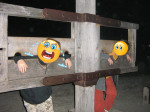This post was originally published on the CORELaborate blog!
Do kids already have grit??
A comment left on Kristen’s Movement in the Classroom post by Carina struck a chord with me. In her comment, Carina wrote, “If my students need a break from our learning every 10 minutes, what am I teaching? How can I make it more engaging and/or meaningful?” This post is not to discredit or in any way deny that humans, both adults and children, need movement and brain breaks! This post is just me questioning whether what I am having my students do in school is engaging and meaningful enough to them. I believe the questions we ask ourselves about the engagement level of the tasks we are asking of our students are important questions! We can argue if the things we are having our students do in school have to be engaging or meaningful to them or not but the truth is that if those tasks are not engaging and meaningful to students, some students will disengage. Carina mentions a post written by John Spencer where he makes an excellent point, when kids are doing something they really like, they do NOT have attention span difficulties. When kids are doing something they like, they will focus for extended periods of time. In John’s post he gives six strategies for cultivating creative focus in our students in class. He’s got some great ideas there. So that made me wonder about the kind of grit and perseverance our kids already have.
Is it all about Engagement?
How to make learning more engaging so that ALL my students are working and producing occupies a lot of my thinking! In a standards-based classroom environment, students can meet any given standard when they are ready there’s no such thing as losing points for learning later than others. Once a student meets standard, that student has met standard just like everyone else. Even then I still have students who do not meet all the standards. They have more time if they need it but they don’t all take advantage of that. We might say that the students who didn’t meet standard and quit trying to meet standard are lacking perseverance or grit. What John Spencer noticed about focus, I notice about perseverance and grit. All this perseverance and grit stuff works really well for things we like and/or are already good at. Kids DO have grit, perseverance, AND can focus for extended periods of time ON THINGS they love! We present perseverance and grit to our students sometimes as if they don’t have it or they don’t know what it is all about but that’s not the issue or problem. So the strategies we need, the real question we are seeking to answer, is how to do we motivate our students to do things that we deem as important for them that they don’t necessarily WANT to do themselves? It isn’t just about having grit or perseverance, it’s about having grit and perseverance to do things they don’t want to do. Or, it will have to be about changing what we have our students do so they will do things they can persevere through!
Compliance or Empowerment?
Some kids do what we ask in our classes and they do so regularly. They trust us and believe that what we are asking them to do will actually help them get the future they want. For the most part, these kids often find that they are good at the things we are asking them to do in our classes so it makes it easier for them to do those things. That is not true for all of our students. Some kids don’t seem to find that what we’re asking them to do is worthwhile or not worth their while. They might try some of what we ask them to do, but won’t persevere because it’s just not interesting enough. If they struggle with the tasks we are asking them to complete, it’s even worse. I have always found it amazing that some kids would rather sit and do nothing than engage in what the other kids in class are doing. So Carina’s question, how do I make what I’m teaching more engaging and meaningful to my students, is the question indeed in my humble opinion.
Is Genius Hour THE Way??
So I wonder, does that mean that all those schools that are embracing Genius Hour are on the right track?? I mean, homeschooling works for many children, and they get to have Genius Hour all the time. I wonder about this because I have never provided Genius Hour time for my students in Science. From my understanding, letting kids choose what they want to learn and how they want to learn it and how they present or share that they learned it, empowers them and motivates them to focus and persevere through difficulties and problems. For teachers, it’s a leap where we will have to trust that our students will learn enough to do well on the standards we are assigned to teach so they can show growth including passing state tests. The teacher must somehow map the skills, content, and standards that all the students are learning when engaged in Genius Hour type projects and activities. I do not doubt that kids are learning, maybe even learning way more than doing something I created for them or something in my school’s scope and sequence or curriculum. The problem is keeping track of what ALL of our students are learning and maintaining a plan from grade level to grade level to ensure students get the content, skills, and standards they need for their future whether it’s college or career. Personally, if I saw an opportunity to teach at a school that had a strong student-centered Genius Hour style, I would want to work there!
So What Do I Do?
I have tried several things to engage more and more of my students.
- I built a 1:1 program in my classroom through grant writing to put technology in the hands of all my students. How can our kids be fully prepared for their futures without using technology in school?
- I went gradeless (here’s mine) to make learning all about intrinsic motivation to learn and not about getting or losing points. I wanted the focus to be about the content and not the grade.
- When going gradeless, especially all by myself while other classes gave grades, didn’t work as expected (students loved having a class with no pressure but many of them used that freedom to do very little or no work), didn’t work I switched to Standards-Based Grading (SBG). SBG turns out to be a happy middle ground between traditional A – F grading and gradeless.
- I’ve used Project-Based Learning (PBL).
- I’ve tried Gamification.
- I brought World of Warcraft to my 6th graders!
- I’ve used technologies that make my presentations more interactive, such as Pear Deck, and make quizzing more exciting, such as Kahoot.
- I give my students choice as to how to show their learning, for example, they can make movies, stop motion animations, Google Slides, comic books, or any other way they come up with. I even have flexibility with the content. As long as they are learning the standards, they can go in different routes from the rest of their classmates.
- Currently, I’m working on a proposal to teach Science to my 6th graders using Lego Mindstorms EV3 programmable robots because we are on a Science adoption cycle and I got inspired at this year’s NCCE Conference! More on this on a future blog post!
You’d think I would have given Genius Hour a shot! Even though I understand that there is no silver bullet in education that will engage or reach ALL students, well at least not ALL the time, I’m still in search of it! It keeps me active and on the hunt. So what have you tried that engages more and more students? Do you have Genius Hour at your school?






















































